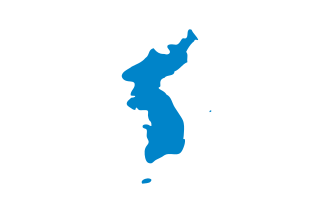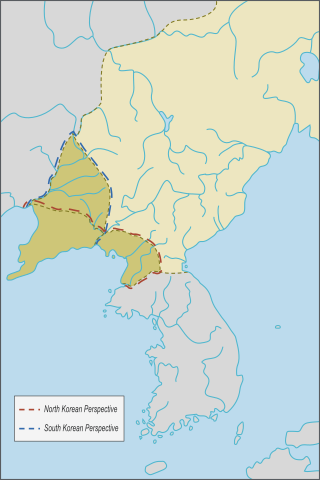
Korea is a peninsular region in East Asia consisting of the Korean Peninsula, Jeju Island, and smaller islands. Since the end of World War II in 1945, it has been politically divided at or near the 38th parallel; in 1948, two states declared independence, both claiming sovereignty over the entire region: North Korea in its northern half and South Korea in the south, which fought the Korean War from 1950 to 1953. The region is bordered by China to the north and Russia to the northeast, across the Amnok (Yalu) and Duman (Tumen) rivers, and is separated from Japan to the southeast by the Korea Strait.

The Lower Paleolithic era on the Korean Peninsula and in Manchuria began roughly half a million years ago. The earliest known Korean pottery dates to around 8000 BC and the Neolithic period began thereafter, followed by the Bronze Age by 2000 BC, and the Iron Age around 700 BC. The Paleolithic people are likely not the direct ancestors of the present Korean people, but their direct ancestors are thought to be the Neolithic People of about 2000 BC.

Balhae, also rendered as Bohai, known by the name Bohea and called Jin was a multiethnic kingdom established in 698 by Dae Joyeong and originally known as the Kingdom of Jin until 713 when its name was changed to Balhae. At its greatest extent it corresponded to what is today Northeast China, the northern half of the Korean Peninsula and the southeastern Russian Far East.

The Changbai Mountains are a major mountain range in East Asia that extends from the Northeast Chinese provinces of Heilongjiang, Jilin and Liaoning, across the China-North Korea border, to the North Korean provinces of Ryanggang and Chagang. They are also referred to as the Šanggiyan Mountains in the Manchu language, or the Great Paekdu in Korean. Most of its peaks exceed 2,000 m (6,600 ft) in height, with the tallest summit being Paektu Mountain at 2,744 m (9,003 ft), which contains the Heaven Lake, the highest volcanic crater lake in the world at an surface elevation of 2,189.1 m (7,182 ft). The protected area Longwanqun National Forest Park is located within the vicinity of the mountain range.
Dae Mu-ye, also known as King Mu, was the second king of the Balhae. He is noted for the military expansion of his domain.
Dae Insu, also known as King Seon was the 10th king of the kingdom of Balhae. He restored national strength, and is remembered today as the last of the great Balhae rulers before its fall.
The Mohe, Malgal, Mogher, or Mojie were historical groups of people that once occupied parts of what is now Northeast Asia during late antiquity. The two most well known Mohe groups were known as the Heishui Mohe, located along the Amur River, and the Sumo Mohe, named after the Songhua River. They have been traditionally defined by the approximate use of what would have been Tungusic languages. The Heishui Mohe are commonly thought as being direct ancestors to the 12th century Jurchens. The Tang documented the Mohe as inhabiting the land of Sushen, to the northeast of the Tang, east of the Turks, and north of Goguryeo.

Korea's military history spans thousands of years, beginning with the ancient nation of Gojoseon and continuing into the present day with the countries of North Korea and South Korea, and is notable for its many successful triumphs over invaders.
Mun of Balhae, also known as Dae Heum-mu, was the third and longest-reigning ruler of the Balhae. He succeeded his father King Mu, upon his death in 737. He was the grandson of Dae Jo-yeong, the founder of Balhae.
The Battle of Tianmenling, or the Battle of Cheonmun-ryeong in Korean, was fought between Dae Jo-yeong, later founder of Balhae, and Li Kaigu (李楷固), a Khitan commander of the Chinese Tang dynasty and Wu Zhou dynasty.

Hokiang, was a province in Northeast China, which was established in 1945. It was c.52,300 sq mi (135,500 km²) in size and the provincial capital was Jiamusi.

The Northern and Southern States period is the period in ancient Korean history when Unified Silla and Balhae coexisted in the south and north of the peninsula, respectively.
Dae Jung-sang (?–698?), also known as Geolgeol Jungsang, was a key contributor to the founding of Balhae, and the father of Dae Jo-yeong, the actual founder of Balhae. Though much of the credit for the founding of Balhae went to his son, many historians still give credit to Dae Jung-sang as the main supporter and leader in the founding of Balhae.

Mishan is a county-level city in the southeast of Heilongjiang Province, China, bordering Russia's Primorsky Krai to the south and southeast. It is under the jurisdiction of the prefecture-level city of Jixi.
The Goguryeo revival movements were various attempts to revive the Kingdom of Goguryeo after its defeat by the Silla-Tang alliance in 668. After 668, several different revival movements were initiated throughout the former territories of Goguryeo and some even in Tang territory. A new theory among Korean historians states that Gung-ye, the founder of Taebong, was a descendant of Anseung and the Go Dynasty. This theory has not been completely accepted yet, as more research is still in process.

Dae Jo-yeong is a South Korean television series aired from September 16, 2006, to December 23, 2007, on KBS1. It tells the life of Dae Jo-yeong, the founder of the kingdom of Balhae.
The Goguryeo controversies are disputes between China and Korea on the history of Goguryeo, an ancient kingdom located in present-day Northeast China and the Korean Peninsula. At the heart of the Goguryeo controversy is which part of history the kingdom belongs to. Korean scholars have the viewpoint that Goguryeo is part of Korean history alone.

Little Goguryeo is the name of a state thought to have existed on the Liaodong Peninsula, proposed by the Japanese scholar Kaizaburo Hino. The existence of the state is debated among scholars. The state was mentioned in historical records, with its leaders recorded as Governors-General subject to the Tang dynasty in the documents of the Tang government. It was supposedly established by the refugees of Goguryeo after its defeat by the Tang dynasty.
Li Kaigu (李楷固), also known as Wu Kaigu (武楷固) from 700 to 705, formally the Duke of Yan (燕公), was a general during the reign of Wu Zetian. He was of Khitan ethnicity.
The Balhae controversies involve disputes between China, Korea, Japan, and Russia, countries that have conducted studies on the historical state of Balhae. The Korean perspective generally considers Balhae to be the successor state of Goguryeo and part of the Northern and Southern States period of Korean history, while Chinese scholars generally consider Balhae to be a state of the Mohe people, a Tungusic ethnic group, and subordinate to the Tang dynasty (618––907). In Russian historiography, Balhae is recognized as the first highly organized independent state formation of the Tungus-Manchurian peoples.









